Perth Arena Project Management: Failings, Gaps in Theory and Ways to Address Them
VerifiedAdded on 2023/06/04
|17
|4823
|436
AI Summary
This article reviews the Perth Arena project from a project management perspective. It discusses the major failings, gaps in theory and ways to address them. The original cost and time estimates for the project were made well before understanding and defining the project. The Perth Arena was estimated to cost $483 million, which was $323 million more as compared to that had been announced by the government in 2005. The major failures in the Perth Arena project were the shortfalls in the governance and management of project that had been suffered by the State to a huge risk than it was intended before.
Contribute Materials
Your contribution can guide someone’s learning journey. Share your
documents today.

Project Management
Secure Best Marks with AI Grader
Need help grading? Try our AI Grader for instant feedback on your assignments.

Contents
Introduction......................................................................................................................................3
Perth Arena project from a project management perspective..........................................................3
Major failings...................................................................................................................................8
Gaps in the theory..........................................................................................................................10
Ways to address the gaps in the Arena project..............................................................................12
Cost Contingency...........................................................................................................................13
Conclusion.....................................................................................................................................14
References......................................................................................................................................15
Introduction......................................................................................................................................3
Perth Arena project from a project management perspective..........................................................3
Major failings...................................................................................................................................8
Gaps in the theory..........................................................................................................................10
Ways to address the gaps in the Arena project..............................................................................12
Cost Contingency...........................................................................................................................13
Conclusion.....................................................................................................................................14
References......................................................................................................................................15
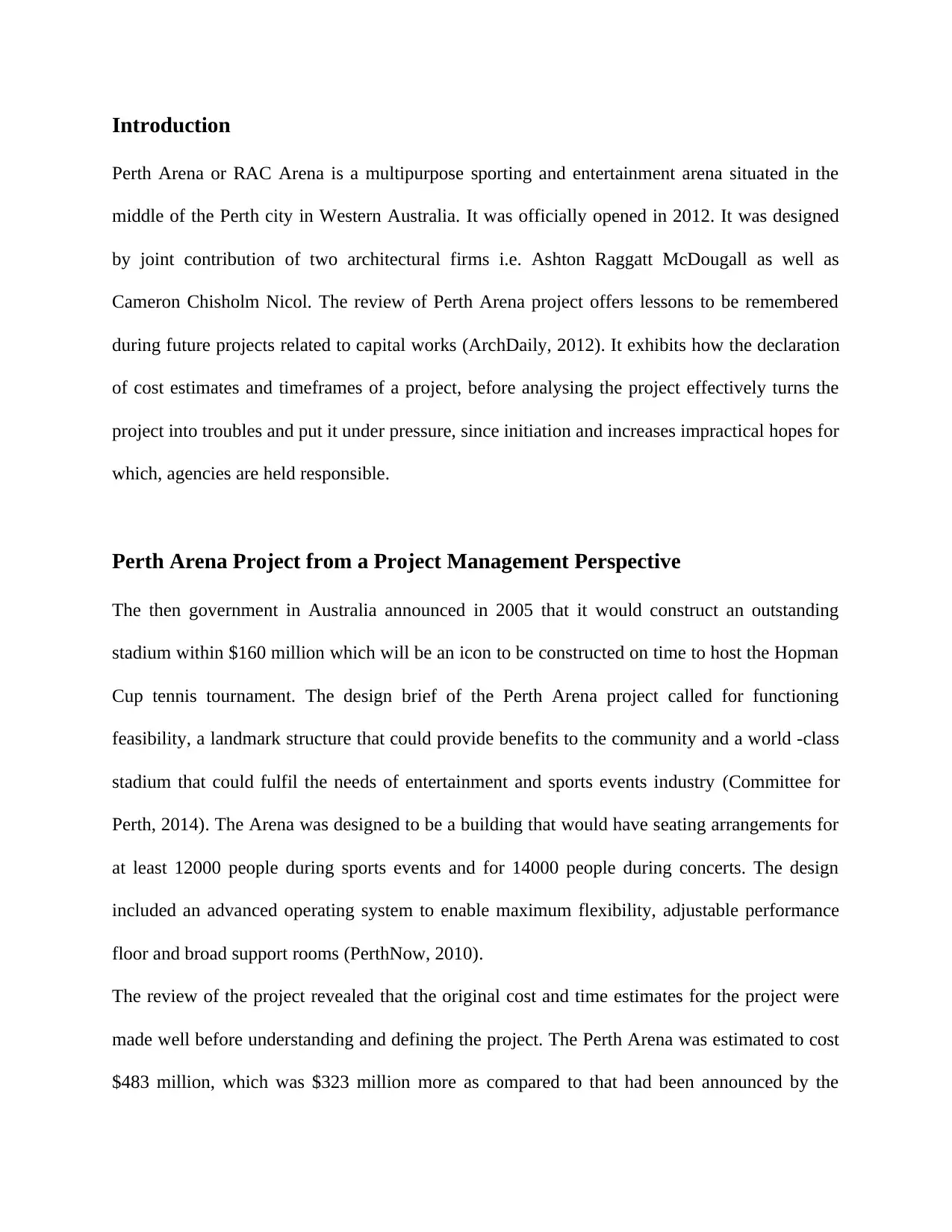
Introduction
Perth Arena or RAC Arena is a multipurpose sporting and entertainment arena situated in the
middle of the Perth city in Western Australia. It was officially opened in 2012. It was designed
by joint contribution of two architectural firms i.e. Ashton Raggatt McDougall as well as
Cameron Chisholm Nicol. The review of Perth Arena project offers lessons to be remembered
during future projects related to capital works (ArchDaily, 2012). It exhibits how the declaration
of cost estimates and timeframes of a project, before analysing the project effectively turns the
project into troubles and put it under pressure, since initiation and increases impractical hopes for
which, agencies are held responsible.
Perth Arena Project from a Project Management Perspective
The then government in Australia announced in 2005 that it would construct an outstanding
stadium within $160 million which will be an icon to be constructed on time to host the Hopman
Cup tennis tournament. The design brief of the Perth Arena project called for functioning
feasibility, a landmark structure that could provide benefits to the community and a world -class
stadium that could fulfil the needs of entertainment and sports events industry (Committee for
Perth, 2014). The Arena was designed to be a building that would have seating arrangements for
at least 12000 people during sports events and for 14000 people during concerts. The design
included an advanced operating system to enable maximum flexibility, adjustable performance
floor and broad support rooms (PerthNow, 2010).
The review of the project revealed that the original cost and time estimates for the project were
made well before understanding and defining the project. The Perth Arena was estimated to cost
$483 million, which was $323 million more as compared to that had been announced by the
Perth Arena or RAC Arena is a multipurpose sporting and entertainment arena situated in the
middle of the Perth city in Western Australia. It was officially opened in 2012. It was designed
by joint contribution of two architectural firms i.e. Ashton Raggatt McDougall as well as
Cameron Chisholm Nicol. The review of Perth Arena project offers lessons to be remembered
during future projects related to capital works (ArchDaily, 2012). It exhibits how the declaration
of cost estimates and timeframes of a project, before analysing the project effectively turns the
project into troubles and put it under pressure, since initiation and increases impractical hopes for
which, agencies are held responsible.
Perth Arena Project from a Project Management Perspective
The then government in Australia announced in 2005 that it would construct an outstanding
stadium within $160 million which will be an icon to be constructed on time to host the Hopman
Cup tennis tournament. The design brief of the Perth Arena project called for functioning
feasibility, a landmark structure that could provide benefits to the community and a world -class
stadium that could fulfil the needs of entertainment and sports events industry (Committee for
Perth, 2014). The Arena was designed to be a building that would have seating arrangements for
at least 12000 people during sports events and for 14000 people during concerts. The design
included an advanced operating system to enable maximum flexibility, adjustable performance
floor and broad support rooms (PerthNow, 2010).
The review of the project revealed that the original cost and time estimates for the project were
made well before understanding and defining the project. The Perth Arena was estimated to cost
$483 million, which was $323 million more as compared to that had been announced by the

government in 2005 (Krol, 2010). The original cost estimates were impractical and were
declared without understanding the needs and requirements of the project (Love, Wang, Sing, &
Sing, 2013). Various changes that were made to the opportunity of the project during
preparation, submitting and contractual award stages added to the costs of the project (Love,
Wang, Sing, & Sing, 2013). On the other hand, the Perth Arena was scheduled to open in 2012,
which was a delay of almost 4 years than that was originally planned. The government
announced the actual opening date for the Perth Arena project well before it was defined in an
adequate manner. The extensions in construction time due to changes in design, further delayed
the opening date of the Perth Arena because of which, the originally planned hosting of the five
Hopman Cup tournaments were at risk (WSP, 2018).
The increase in the costs was due to the hugely underestimated project costs at the inception of
the project along with inaccurate estimates for successive changes in the design and project risks.
The original cost estimation for the Perth Arena project involved the management and
procurement, design, construction and ground works and other operational costs to be $160
million which was the approved budget for this project. It was estimated to be $320 million
during pre-tender and $343 million during post contract award (Department of Finance, 2018). In
2009, after analysing the requirements of this project and changes made in the design, the total
cost increased to $ 483 including car parking area costs and that too excluding the GST (Office
of the Auditor General Western Australia, 2012). The increase in the cost estimates to $323
million, which proved that the original budget of $160 million was a significant underestimation
of the project cost (Love, Wang, Sing, & Sing, 2013). It was declared even before the completion
of the design, which means that the final project possibility was yet to be defined and the budget
approved was based on standard square meter rates for a small size stadium. Moreover, in 2006,
declared without understanding the needs and requirements of the project (Love, Wang, Sing, &
Sing, 2013). Various changes that were made to the opportunity of the project during
preparation, submitting and contractual award stages added to the costs of the project (Love,
Wang, Sing, & Sing, 2013). On the other hand, the Perth Arena was scheduled to open in 2012,
which was a delay of almost 4 years than that was originally planned. The government
announced the actual opening date for the Perth Arena project well before it was defined in an
adequate manner. The extensions in construction time due to changes in design, further delayed
the opening date of the Perth Arena because of which, the originally planned hosting of the five
Hopman Cup tournaments were at risk (WSP, 2018).
The increase in the costs was due to the hugely underestimated project costs at the inception of
the project along with inaccurate estimates for successive changes in the design and project risks.
The original cost estimation for the Perth Arena project involved the management and
procurement, design, construction and ground works and other operational costs to be $160
million which was the approved budget for this project. It was estimated to be $320 million
during pre-tender and $343 million during post contract award (Department of Finance, 2018). In
2009, after analysing the requirements of this project and changes made in the design, the total
cost increased to $ 483 including car parking area costs and that too excluding the GST (Office
of the Auditor General Western Australia, 2012). The increase in the cost estimates to $323
million, which proved that the original budget of $160 million was a significant underestimation
of the project cost (Love, Wang, Sing, & Sing, 2013). It was declared even before the completion
of the design, which means that the final project possibility was yet to be defined and the budget
approved was based on standard square meter rates for a small size stadium. Moreover, in 2006,
Secure Best Marks with AI Grader
Need help grading? Try our AI Grader for instant feedback on your assignments.
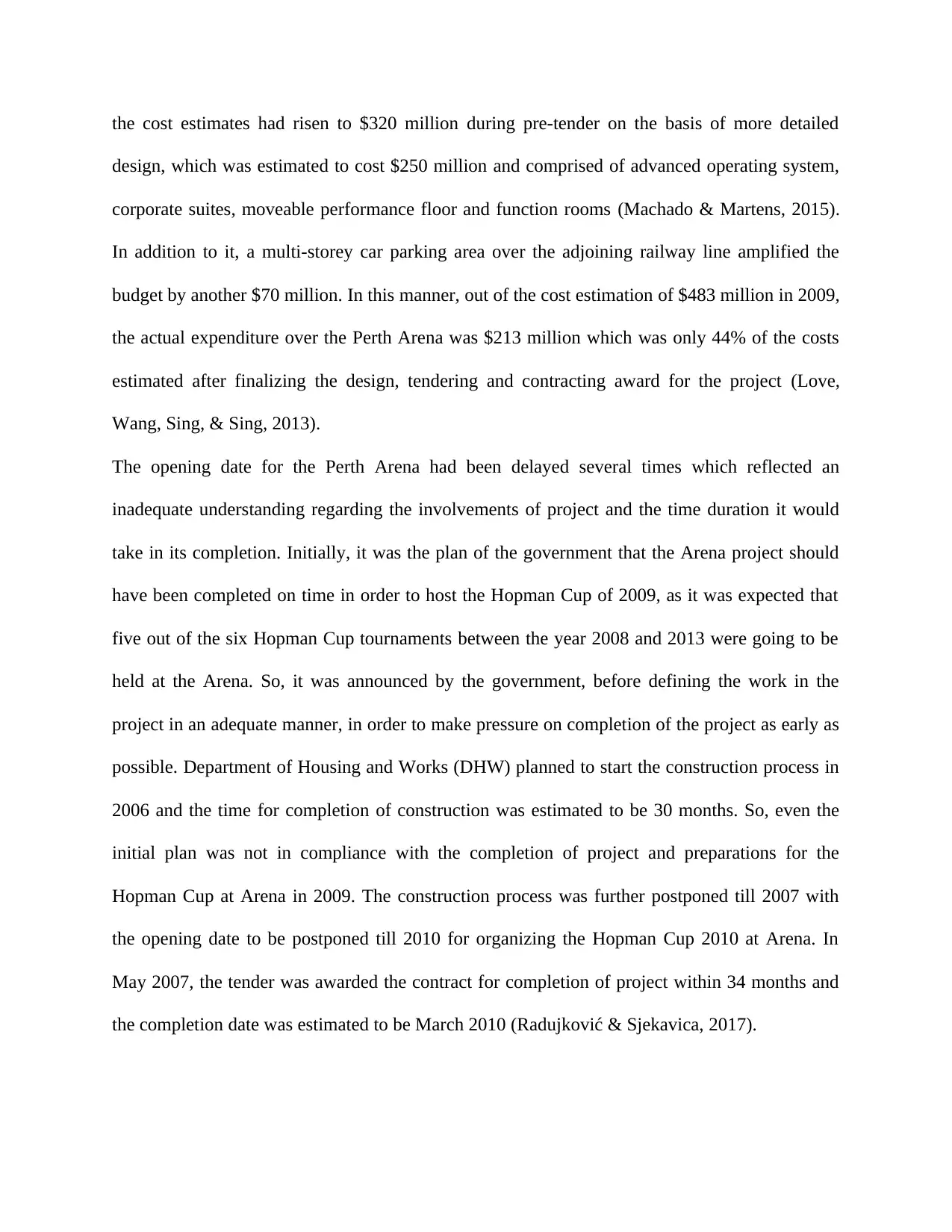
the cost estimates had risen to $320 million during pre-tender on the basis of more detailed
design, which was estimated to cost $250 million and comprised of advanced operating system,
corporate suites, moveable performance floor and function rooms (Machado & Martens, 2015).
In addition to it, a multi-storey car parking area over the adjoining railway line amplified the
budget by another $70 million. In this manner, out of the cost estimation of $483 million in 2009,
the actual expenditure over the Perth Arena was $213 million which was only 44% of the costs
estimated after finalizing the design, tendering and contracting award for the project (Love,
Wang, Sing, & Sing, 2013).
The opening date for the Perth Arena had been delayed several times which reflected an
inadequate understanding regarding the involvements of project and the time duration it would
take in its completion. Initially, it was the plan of the government that the Arena project should
have been completed on time in order to host the Hopman Cup of 2009, as it was expected that
five out of the six Hopman Cup tournaments between the year 2008 and 2013 were going to be
held at the Arena. So, it was announced by the government, before defining the work in the
project in an adequate manner, in order to make pressure on completion of the project as early as
possible. Department of Housing and Works (DHW) planned to start the construction process in
2006 and the time for completion of construction was estimated to be 30 months. So, even the
initial plan was not in compliance with the completion of project and preparations for the
Hopman Cup at Arena in 2009. The construction process was further postponed till 2007 with
the opening date to be postponed till 2010 for organizing the Hopman Cup 2010 at Arena. In
May 2007, the tender was awarded the contract for completion of project within 34 months and
the completion date was estimated to be March 2010 (Radujković & Sjekavica, 2017).
design, which was estimated to cost $250 million and comprised of advanced operating system,
corporate suites, moveable performance floor and function rooms (Machado & Martens, 2015).
In addition to it, a multi-storey car parking area over the adjoining railway line amplified the
budget by another $70 million. In this manner, out of the cost estimation of $483 million in 2009,
the actual expenditure over the Perth Arena was $213 million which was only 44% of the costs
estimated after finalizing the design, tendering and contracting award for the project (Love,
Wang, Sing, & Sing, 2013).
The opening date for the Perth Arena had been delayed several times which reflected an
inadequate understanding regarding the involvements of project and the time duration it would
take in its completion. Initially, it was the plan of the government that the Arena project should
have been completed on time in order to host the Hopman Cup of 2009, as it was expected that
five out of the six Hopman Cup tournaments between the year 2008 and 2013 were going to be
held at the Arena. So, it was announced by the government, before defining the work in the
project in an adequate manner, in order to make pressure on completion of the project as early as
possible. Department of Housing and Works (DHW) planned to start the construction process in
2006 and the time for completion of construction was estimated to be 30 months. So, even the
initial plan was not in compliance with the completion of project and preparations for the
Hopman Cup at Arena in 2009. The construction process was further postponed till 2007 with
the opening date to be postponed till 2010 for organizing the Hopman Cup 2010 at Arena. In
May 2007, the tender was awarded the contract for completion of project within 34 months and
the completion date was estimated to be March 2010 (Radujković & Sjekavica, 2017).
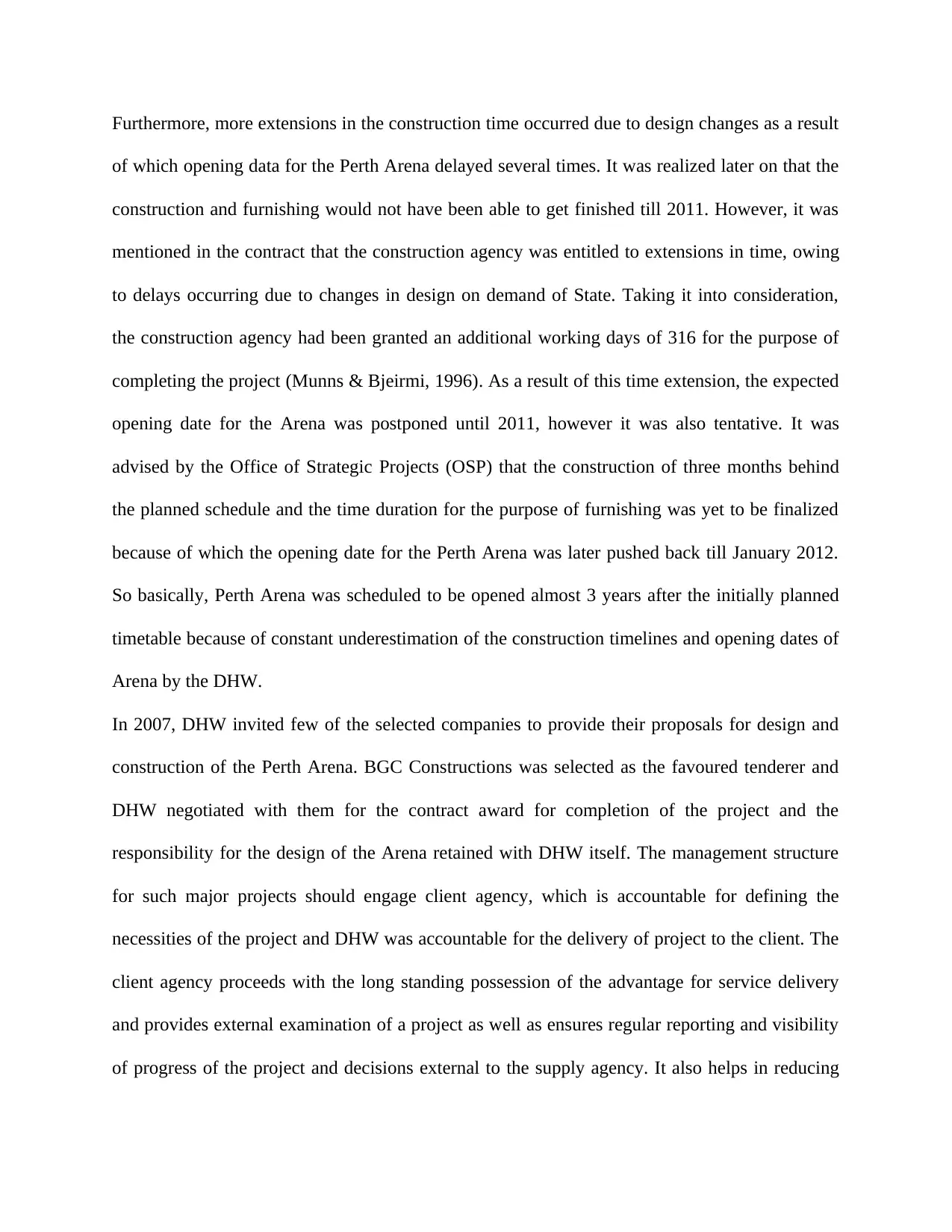
Furthermore, more extensions in the construction time occurred due to design changes as a result
of which opening data for the Perth Arena delayed several times. It was realized later on that the
construction and furnishing would not have been able to get finished till 2011. However, it was
mentioned in the contract that the construction agency was entitled to extensions in time, owing
to delays occurring due to changes in design on demand of State. Taking it into consideration,
the construction agency had been granted an additional working days of 316 for the purpose of
completing the project (Munns & Bjeirmi, 1996). As a result of this time extension, the expected
opening date for the Arena was postponed until 2011, however it was also tentative. It was
advised by the Office of Strategic Projects (OSP) that the construction of three months behind
the planned schedule and the time duration for the purpose of furnishing was yet to be finalized
because of which the opening date for the Perth Arena was later pushed back till January 2012.
So basically, Perth Arena was scheduled to be opened almost 3 years after the initially planned
timetable because of constant underestimation of the construction timelines and opening dates of
Arena by the DHW.
In 2007, DHW invited few of the selected companies to provide their proposals for design and
construction of the Perth Arena. BGC Constructions was selected as the favoured tenderer and
DHW negotiated with them for the contract award for completion of the project and the
responsibility for the design of the Arena retained with DHW itself. The management structure
for such major projects should engage client agency, which is accountable for defining the
necessities of the project and DHW was accountable for the delivery of project to the client. The
client agency proceeds with the long standing possession of the advantage for service delivery
and provides external examination of a project as well as ensures regular reporting and visibility
of progress of the project and decisions external to the supply agency. It also helps in reducing
of which opening data for the Perth Arena delayed several times. It was realized later on that the
construction and furnishing would not have been able to get finished till 2011. However, it was
mentioned in the contract that the construction agency was entitled to extensions in time, owing
to delays occurring due to changes in design on demand of State. Taking it into consideration,
the construction agency had been granted an additional working days of 316 for the purpose of
completing the project (Munns & Bjeirmi, 1996). As a result of this time extension, the expected
opening date for the Arena was postponed until 2011, however it was also tentative. It was
advised by the Office of Strategic Projects (OSP) that the construction of three months behind
the planned schedule and the time duration for the purpose of furnishing was yet to be finalized
because of which the opening date for the Perth Arena was later pushed back till January 2012.
So basically, Perth Arena was scheduled to be opened almost 3 years after the initially planned
timetable because of constant underestimation of the construction timelines and opening dates of
Arena by the DHW.
In 2007, DHW invited few of the selected companies to provide their proposals for design and
construction of the Perth Arena. BGC Constructions was selected as the favoured tenderer and
DHW negotiated with them for the contract award for completion of the project and the
responsibility for the design of the Arena retained with DHW itself. The management structure
for such major projects should engage client agency, which is accountable for defining the
necessities of the project and DHW was accountable for the delivery of project to the client. The
client agency proceeds with the long standing possession of the advantage for service delivery
and provides external examination of a project as well as ensures regular reporting and visibility
of progress of the project and decisions external to the supply agency. It also helps in reducing
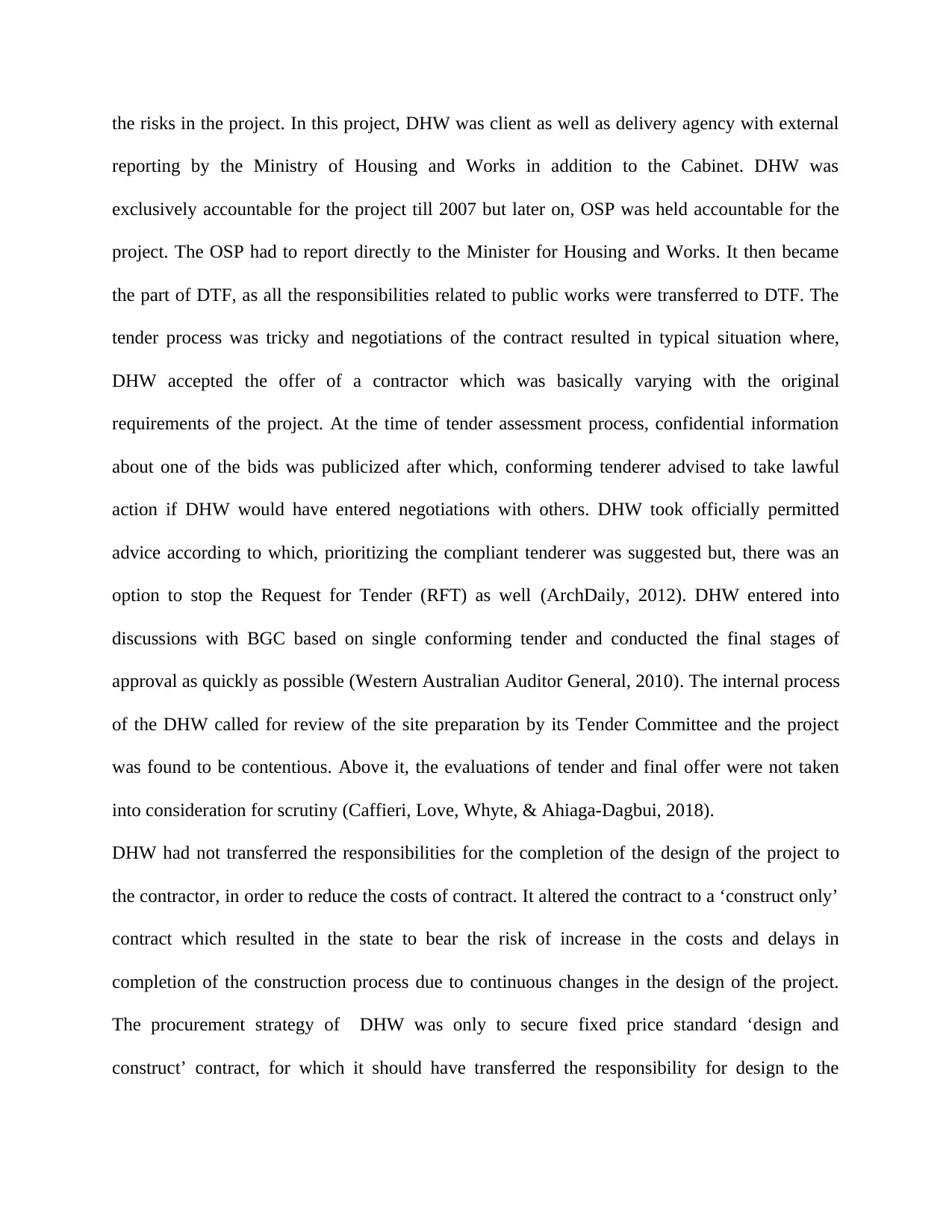
the risks in the project. In this project, DHW was client as well as delivery agency with external
reporting by the Ministry of Housing and Works in addition to the Cabinet. DHW was
exclusively accountable for the project till 2007 but later on, OSP was held accountable for the
project. The OSP had to report directly to the Minister for Housing and Works. It then became
the part of DTF, as all the responsibilities related to public works were transferred to DTF. The
tender process was tricky and negotiations of the contract resulted in typical situation where,
DHW accepted the offer of a contractor which was basically varying with the original
requirements of the project. At the time of tender assessment process, confidential information
about one of the bids was publicized after which, conforming tenderer advised to take lawful
action if DHW would have entered negotiations with others. DHW took officially permitted
advice according to which, prioritizing the compliant tenderer was suggested but, there was an
option to stop the Request for Tender (RFT) as well (ArchDaily, 2012). DHW entered into
discussions with BGC based on single conforming tender and conducted the final stages of
approval as quickly as possible (Western Australian Auditor General, 2010). The internal process
of the DHW called for review of the site preparation by its Tender Committee and the project
was found to be contentious. Above it, the evaluations of tender and final offer were not taken
into consideration for scrutiny (Caffieri, Love, Whyte, & Ahiaga-Dagbui, 2018).
DHW had not transferred the responsibilities for the completion of the design of the project to
the contractor, in order to reduce the costs of contract. It altered the contract to a ‘construct only’
contract which resulted in the state to bear the risk of increase in the costs and delays in
completion of the construction process due to continuous changes in the design of the project.
The procurement strategy of DHW was only to secure fixed price standard ‘design and
construct’ contract, for which it should have transferred the responsibility for design to the
reporting by the Ministry of Housing and Works in addition to the Cabinet. DHW was
exclusively accountable for the project till 2007 but later on, OSP was held accountable for the
project. The OSP had to report directly to the Minister for Housing and Works. It then became
the part of DTF, as all the responsibilities related to public works were transferred to DTF. The
tender process was tricky and negotiations of the contract resulted in typical situation where,
DHW accepted the offer of a contractor which was basically varying with the original
requirements of the project. At the time of tender assessment process, confidential information
about one of the bids was publicized after which, conforming tenderer advised to take lawful
action if DHW would have entered negotiations with others. DHW took officially permitted
advice according to which, prioritizing the compliant tenderer was suggested but, there was an
option to stop the Request for Tender (RFT) as well (ArchDaily, 2012). DHW entered into
discussions with BGC based on single conforming tender and conducted the final stages of
approval as quickly as possible (Western Australian Auditor General, 2010). The internal process
of the DHW called for review of the site preparation by its Tender Committee and the project
was found to be contentious. Above it, the evaluations of tender and final offer were not taken
into consideration for scrutiny (Caffieri, Love, Whyte, & Ahiaga-Dagbui, 2018).
DHW had not transferred the responsibilities for the completion of the design of the project to
the contractor, in order to reduce the costs of contract. It altered the contract to a ‘construct only’
contract which resulted in the state to bear the risk of increase in the costs and delays in
completion of the construction process due to continuous changes in the design of the project.
The procurement strategy of DHW was only to secure fixed price standard ‘design and
construct’ contract, for which it should have transferred the responsibility for design to the
Paraphrase This Document
Need a fresh take? Get an instant paraphrase of this document with our AI Paraphraser
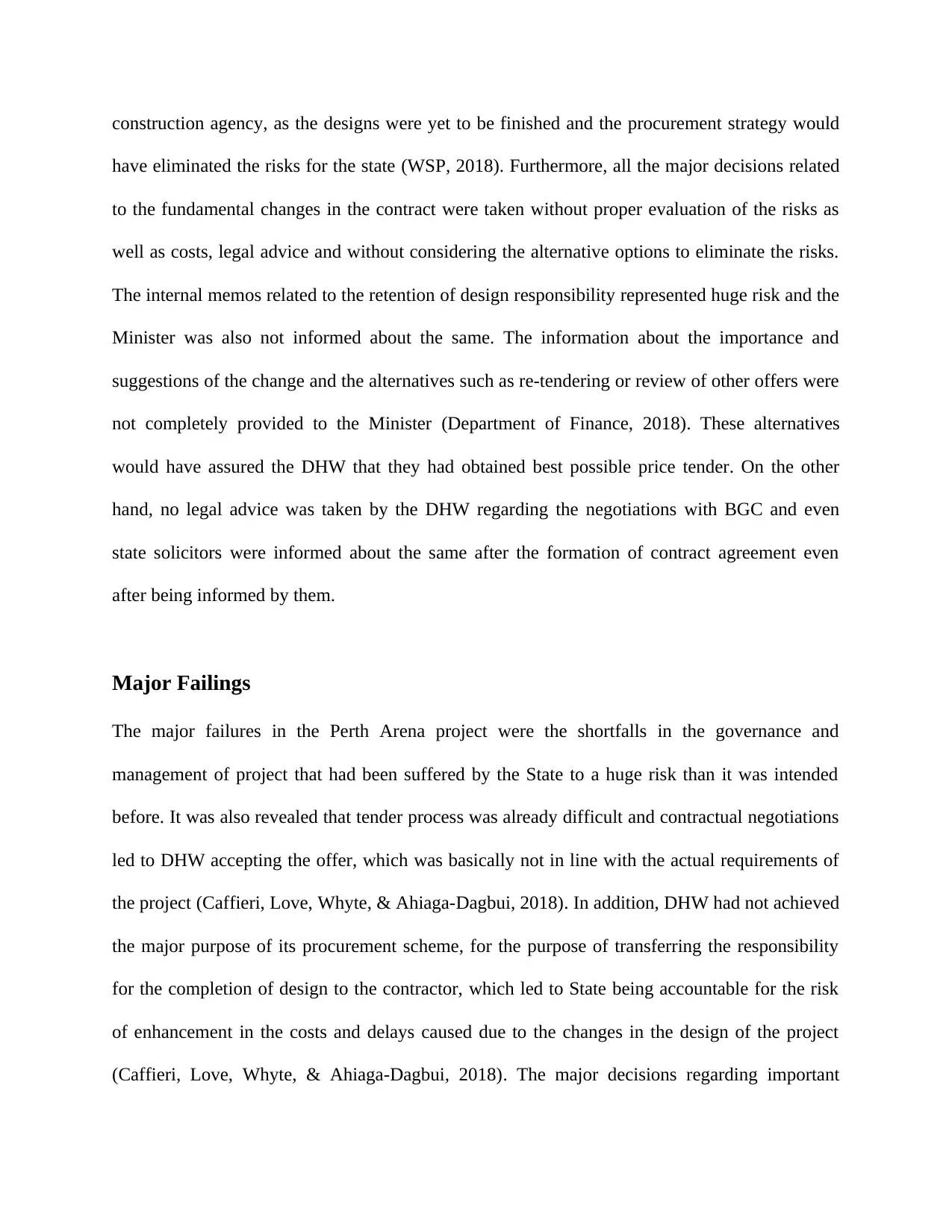
construction agency, as the designs were yet to be finished and the procurement strategy would
have eliminated the risks for the state (WSP, 2018). Furthermore, all the major decisions related
to the fundamental changes in the contract were taken without proper evaluation of the risks as
well as costs, legal advice and without considering the alternative options to eliminate the risks.
The internal memos related to the retention of design responsibility represented huge risk and the
Minister was also not informed about the same. The information about the importance and
suggestions of the change and the alternatives such as re-tendering or review of other offers were
not completely provided to the Minister (Department of Finance, 2018). These alternatives
would have assured the DHW that they had obtained best possible price tender. On the other
hand, no legal advice was taken by the DHW regarding the negotiations with BGC and even
state solicitors were informed about the same after the formation of contract agreement even
after being informed by them.
Major Failings
The major failures in the Perth Arena project were the shortfalls in the governance and
management of project that had been suffered by the State to a huge risk than it was intended
before. It was also revealed that tender process was already difficult and contractual negotiations
led to DHW accepting the offer, which was basically not in line with the actual requirements of
the project (Caffieri, Love, Whyte, & Ahiaga-Dagbui, 2018). In addition, DHW had not achieved
the major purpose of its procurement scheme, for the purpose of transferring the responsibility
for the completion of design to the contractor, which led to State being accountable for the risk
of enhancement in the costs and delays caused due to the changes in the design of the project
(Caffieri, Love, Whyte, & Ahiaga-Dagbui, 2018). The major decisions regarding important
have eliminated the risks for the state (WSP, 2018). Furthermore, all the major decisions related
to the fundamental changes in the contract were taken without proper evaluation of the risks as
well as costs, legal advice and without considering the alternative options to eliminate the risks.
The internal memos related to the retention of design responsibility represented huge risk and the
Minister was also not informed about the same. The information about the importance and
suggestions of the change and the alternatives such as re-tendering or review of other offers were
not completely provided to the Minister (Department of Finance, 2018). These alternatives
would have assured the DHW that they had obtained best possible price tender. On the other
hand, no legal advice was taken by the DHW regarding the negotiations with BGC and even
state solicitors were informed about the same after the formation of contract agreement even
after being informed by them.
Major Failings
The major failures in the Perth Arena project were the shortfalls in the governance and
management of project that had been suffered by the State to a huge risk than it was intended
before. It was also revealed that tender process was already difficult and contractual negotiations
led to DHW accepting the offer, which was basically not in line with the actual requirements of
the project (Caffieri, Love, Whyte, & Ahiaga-Dagbui, 2018). In addition, DHW had not achieved
the major purpose of its procurement scheme, for the purpose of transferring the responsibility
for the completion of design to the contractor, which led to State being accountable for the risk
of enhancement in the costs and delays caused due to the changes in the design of the project
(Caffieri, Love, Whyte, & Ahiaga-Dagbui, 2018). The major decisions regarding important
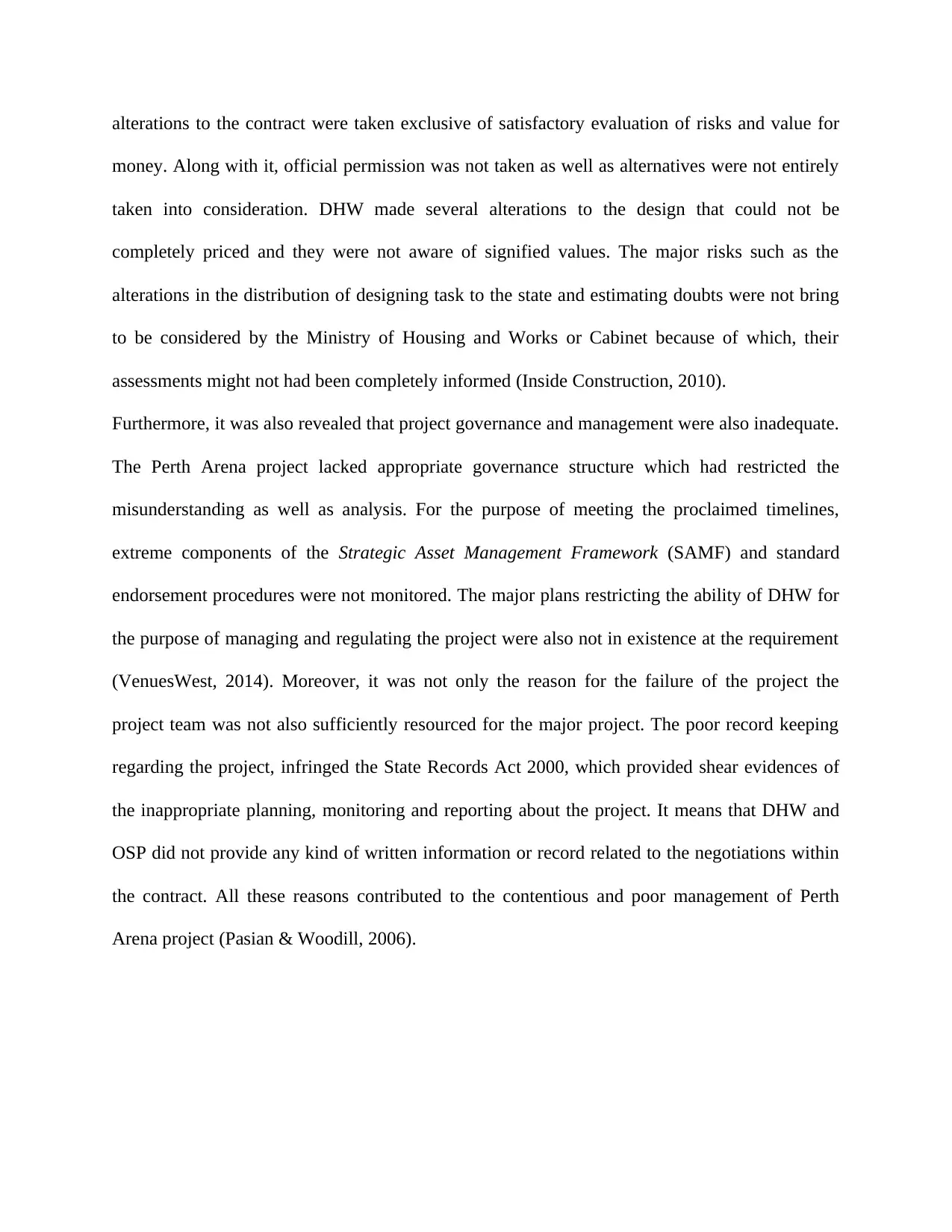
alterations to the contract were taken exclusive of satisfactory evaluation of risks and value for
money. Along with it, official permission was not taken as well as alternatives were not entirely
taken into consideration. DHW made several alterations to the design that could not be
completely priced and they were not aware of signified values. The major risks such as the
alterations in the distribution of designing task to the state and estimating doubts were not bring
to be considered by the Ministry of Housing and Works or Cabinet because of which, their
assessments might not had been completely informed (Inside Construction, 2010).
Furthermore, it was also revealed that project governance and management were also inadequate.
The Perth Arena project lacked appropriate governance structure which had restricted the
misunderstanding as well as analysis. For the purpose of meeting the proclaimed timelines,
extreme components of the Strategic Asset Management Framework (SAMF) and standard
endorsement procedures were not monitored. The major plans restricting the ability of DHW for
the purpose of managing and regulating the project were also not in existence at the requirement
(VenuesWest, 2014). Moreover, it was not only the reason for the failure of the project the
project team was not also sufficiently resourced for the major project. The poor record keeping
regarding the project, infringed the State Records Act 2000, which provided shear evidences of
the inappropriate planning, monitoring and reporting about the project. It means that DHW and
OSP did not provide any kind of written information or record related to the negotiations within
the contract. All these reasons contributed to the contentious and poor management of Perth
Arena project (Pasian & Woodill, 2006).
money. Along with it, official permission was not taken as well as alternatives were not entirely
taken into consideration. DHW made several alterations to the design that could not be
completely priced and they were not aware of signified values. The major risks such as the
alterations in the distribution of designing task to the state and estimating doubts were not bring
to be considered by the Ministry of Housing and Works or Cabinet because of which, their
assessments might not had been completely informed (Inside Construction, 2010).
Furthermore, it was also revealed that project governance and management were also inadequate.
The Perth Arena project lacked appropriate governance structure which had restricted the
misunderstanding as well as analysis. For the purpose of meeting the proclaimed timelines,
extreme components of the Strategic Asset Management Framework (SAMF) and standard
endorsement procedures were not monitored. The major plans restricting the ability of DHW for
the purpose of managing and regulating the project were also not in existence at the requirement
(VenuesWest, 2014). Moreover, it was not only the reason for the failure of the project the
project team was not also sufficiently resourced for the major project. The poor record keeping
regarding the project, infringed the State Records Act 2000, which provided shear evidences of
the inappropriate planning, monitoring and reporting about the project. It means that DHW and
OSP did not provide any kind of written information or record related to the negotiations within
the contract. All these reasons contributed to the contentious and poor management of Perth
Arena project (Pasian & Woodill, 2006).

Gaps in the Theory
The public sector supervisory body has criticized the state government department and held them
accountable for inappropriate planning and mismanaging the Perth Arena stadium project. It was
found by the Auditor General Colin Murphy that the governance of DHW failed to notice the
project management and, administrations were not enough and normal processes were not being
followed. The initial estimation of costs and opening date for the Perth Arena project were found
to be impractical and were taken before the project was implicit or clear as per the Auditor
General. Due to failure in managing as well as administering the Arena project, the budget has
increased to $ 483 million which is 3 times than the initially planned cost and, the time overrun
was almost three years. Additionally, there was risk that the costs as well as delay in the opening
date might extend more till the completion of the project (Department of Finance, 2018).
The Perth Arena project was not planned and scoped in a proper manner with major parts of the
normal processes being missed out or completed in rush. Furthermore, the process of tender and
negotiations were conducted in rush, which should have taken sufficient time to analyze the best
suitable tender. The possible risks to the state or substitute possibilities to the final proposal were
not taken into consideration. In order to decrease the costs, the DHW considered BCG
Construction for the purpose of constructing the Arena project only (Committee for Perth, 2014).
The state took the responsibility for increasing the costs and delays that result from the changes
in the designs. The report of the Auditor General revealed that the decrease in the costs of the
contract has been cancelled by successive enhancement in the costs as well as the extension of
time in order to complete the Arena project. Moreover, most of the changes to the design of the
project were made during the period of negotiations in the contract by effectively understanding
the appropriate estimation of costs incurred due to changes in the design as well as its impact on
The public sector supervisory body has criticized the state government department and held them
accountable for inappropriate planning and mismanaging the Perth Arena stadium project. It was
found by the Auditor General Colin Murphy that the governance of DHW failed to notice the
project management and, administrations were not enough and normal processes were not being
followed. The initial estimation of costs and opening date for the Perth Arena project were found
to be impractical and were taken before the project was implicit or clear as per the Auditor
General. Due to failure in managing as well as administering the Arena project, the budget has
increased to $ 483 million which is 3 times than the initially planned cost and, the time overrun
was almost three years. Additionally, there was risk that the costs as well as delay in the opening
date might extend more till the completion of the project (Department of Finance, 2018).
The Perth Arena project was not planned and scoped in a proper manner with major parts of the
normal processes being missed out or completed in rush. Furthermore, the process of tender and
negotiations were conducted in rush, which should have taken sufficient time to analyze the best
suitable tender. The possible risks to the state or substitute possibilities to the final proposal were
not taken into consideration. In order to decrease the costs, the DHW considered BCG
Construction for the purpose of constructing the Arena project only (Committee for Perth, 2014).
The state took the responsibility for increasing the costs and delays that result from the changes
in the designs. The report of the Auditor General revealed that the decrease in the costs of the
contract has been cancelled by successive enhancement in the costs as well as the extension of
time in order to complete the Arena project. Moreover, most of the changes to the design of the
project were made during the period of negotiations in the contract by effectively understanding
the appropriate estimation of costs incurred due to changes in the design as well as its impact on
Secure Best Marks with AI Grader
Need help grading? Try our AI Grader for instant feedback on your assignments.
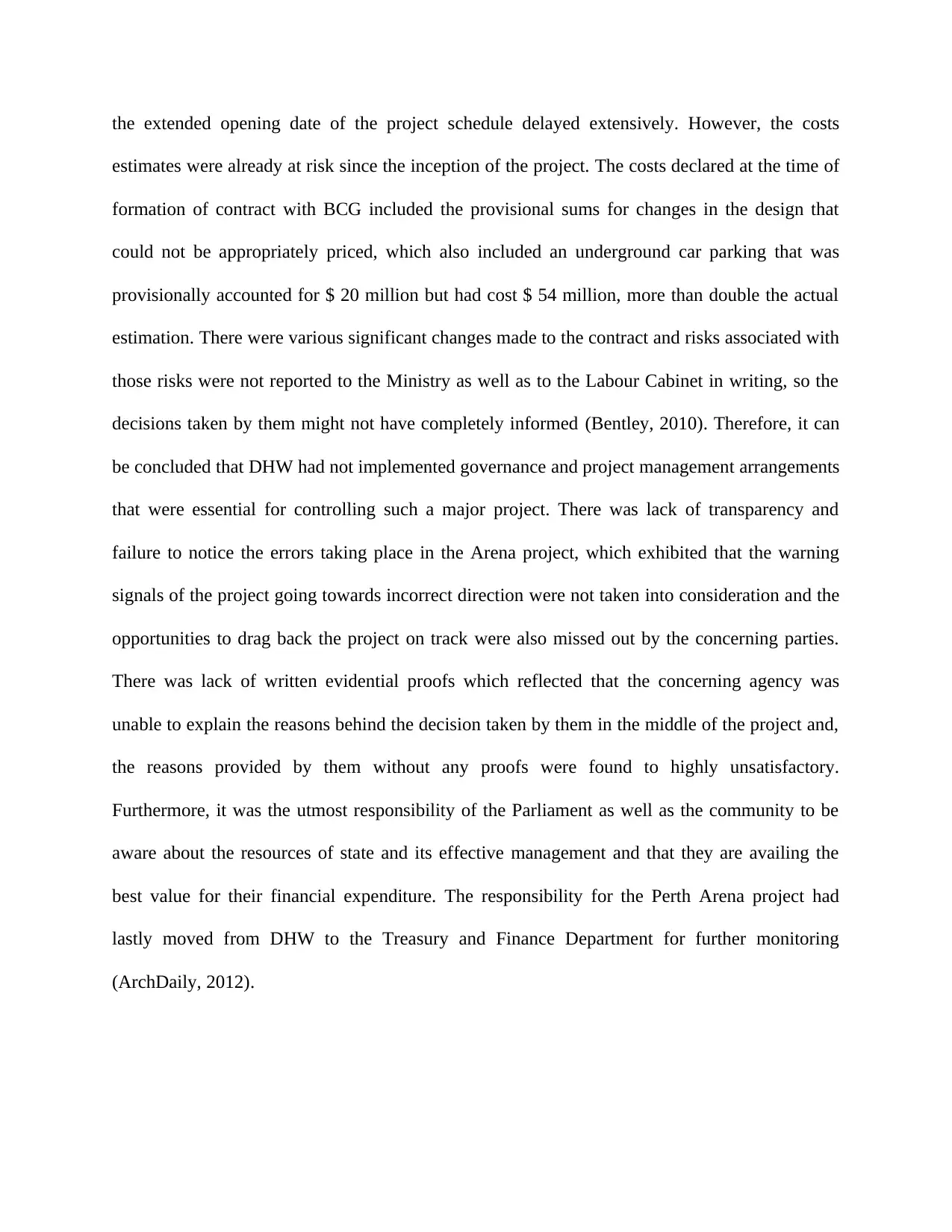
the extended opening date of the project schedule delayed extensively. However, the costs
estimates were already at risk since the inception of the project. The costs declared at the time of
formation of contract with BCG included the provisional sums for changes in the design that
could not be appropriately priced, which also included an underground car parking that was
provisionally accounted for $ 20 million but had cost $ 54 million, more than double the actual
estimation. There were various significant changes made to the contract and risks associated with
those risks were not reported to the Ministry as well as to the Labour Cabinet in writing, so the
decisions taken by them might not have completely informed (Bentley, 2010). Therefore, it can
be concluded that DHW had not implemented governance and project management arrangements
that were essential for controlling such a major project. There was lack of transparency and
failure to notice the errors taking place in the Arena project, which exhibited that the warning
signals of the project going towards incorrect direction were not taken into consideration and the
opportunities to drag back the project on track were also missed out by the concerning parties.
There was lack of written evidential proofs which reflected that the concerning agency was
unable to explain the reasons behind the decision taken by them in the middle of the project and,
the reasons provided by them without any proofs were found to highly unsatisfactory.
Furthermore, it was the utmost responsibility of the Parliament as well as the community to be
aware about the resources of state and its effective management and that they are availing the
best value for their financial expenditure. The responsibility for the Perth Arena project had
lastly moved from DHW to the Treasury and Finance Department for further monitoring
(ArchDaily, 2012).
estimates were already at risk since the inception of the project. The costs declared at the time of
formation of contract with BCG included the provisional sums for changes in the design that
could not be appropriately priced, which also included an underground car parking that was
provisionally accounted for $ 20 million but had cost $ 54 million, more than double the actual
estimation. There were various significant changes made to the contract and risks associated with
those risks were not reported to the Ministry as well as to the Labour Cabinet in writing, so the
decisions taken by them might not have completely informed (Bentley, 2010). Therefore, it can
be concluded that DHW had not implemented governance and project management arrangements
that were essential for controlling such a major project. There was lack of transparency and
failure to notice the errors taking place in the Arena project, which exhibited that the warning
signals of the project going towards incorrect direction were not taken into consideration and the
opportunities to drag back the project on track were also missed out by the concerning parties.
There was lack of written evidential proofs which reflected that the concerning agency was
unable to explain the reasons behind the decision taken by them in the middle of the project and,
the reasons provided by them without any proofs were found to highly unsatisfactory.
Furthermore, it was the utmost responsibility of the Parliament as well as the community to be
aware about the resources of state and its effective management and that they are availing the
best value for their financial expenditure. The responsibility for the Perth Arena project had
lastly moved from DHW to the Treasury and Finance Department for further monitoring
(ArchDaily, 2012).
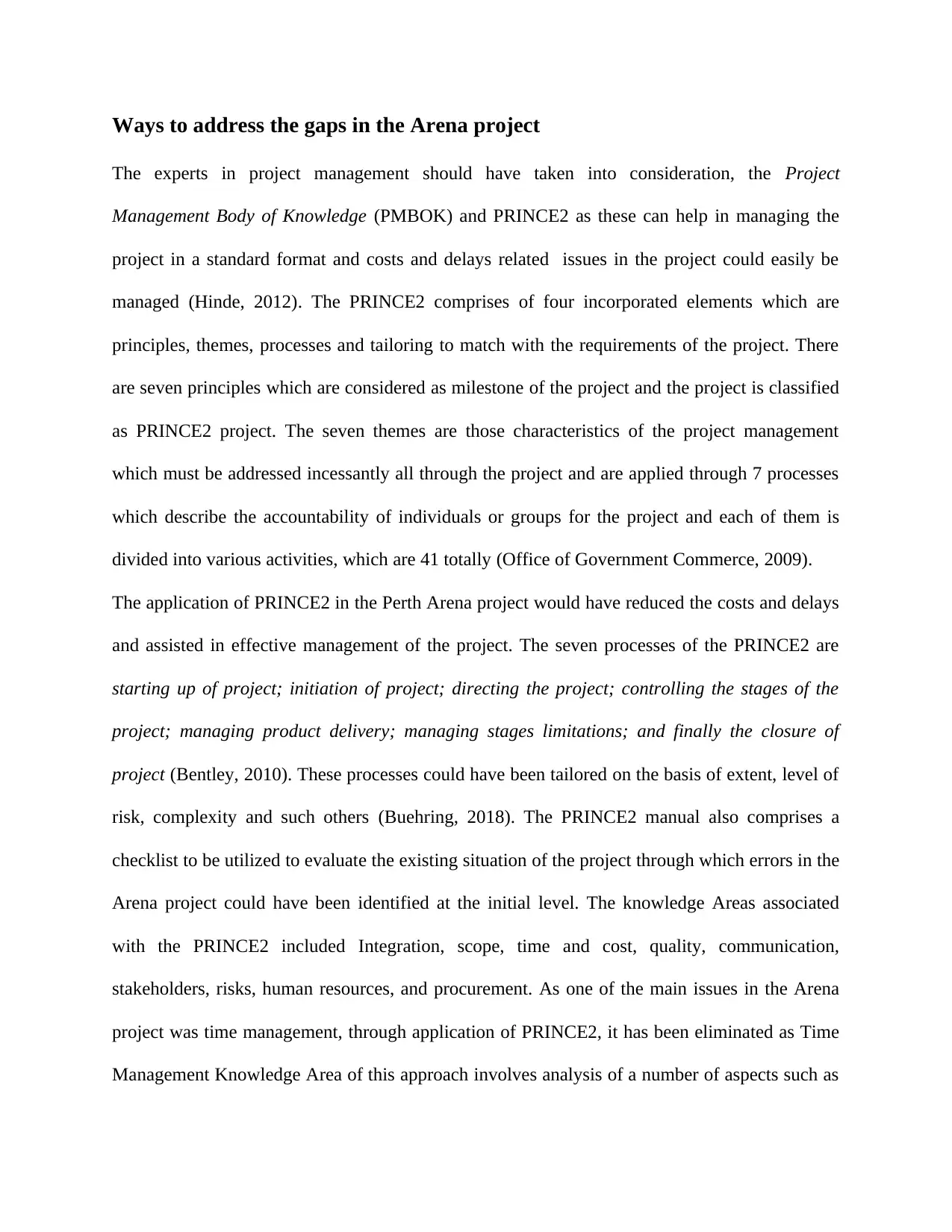
Ways to address the gaps in the Arena project
The experts in project management should have taken into consideration, the Project
Management Body of Knowledge (PMBOK) and PRINCE2 as these can help in managing the
project in a standard format and costs and delays related issues in the project could easily be
managed (Hinde, 2012). The PRINCE2 comprises of four incorporated elements which are
principles, themes, processes and tailoring to match with the requirements of the project. There
are seven principles which are considered as milestone of the project and the project is classified
as PRINCE2 project. The seven themes are those characteristics of the project management
which must be addressed incessantly all through the project and are applied through 7 processes
which describe the accountability of individuals or groups for the project and each of them is
divided into various activities, which are 41 totally (Office of Government Commerce, 2009).
The application of PRINCE2 in the Perth Arena project would have reduced the costs and delays
and assisted in effective management of the project. The seven processes of the PRINCE2 are
starting up of project; initiation of project; directing the project; controlling the stages of the
project; managing product delivery; managing stages limitations; and finally the closure of
project (Bentley, 2010). These processes could have been tailored on the basis of extent, level of
risk, complexity and such others (Buehring, 2018). The PRINCE2 manual also comprises a
checklist to be utilized to evaluate the existing situation of the project through which errors in the
Arena project could have been identified at the initial level. The knowledge Areas associated
with the PRINCE2 included Integration, scope, time and cost, quality, communication,
stakeholders, risks, human resources, and procurement. As one of the main issues in the Arena
project was time management, through application of PRINCE2, it has been eliminated as Time
Management Knowledge Area of this approach involves analysis of a number of aspects such as
The experts in project management should have taken into consideration, the Project
Management Body of Knowledge (PMBOK) and PRINCE2 as these can help in managing the
project in a standard format and costs and delays related issues in the project could easily be
managed (Hinde, 2012). The PRINCE2 comprises of four incorporated elements which are
principles, themes, processes and tailoring to match with the requirements of the project. There
are seven principles which are considered as milestone of the project and the project is classified
as PRINCE2 project. The seven themes are those characteristics of the project management
which must be addressed incessantly all through the project and are applied through 7 processes
which describe the accountability of individuals or groups for the project and each of them is
divided into various activities, which are 41 totally (Office of Government Commerce, 2009).
The application of PRINCE2 in the Perth Arena project would have reduced the costs and delays
and assisted in effective management of the project. The seven processes of the PRINCE2 are
starting up of project; initiation of project; directing the project; controlling the stages of the
project; managing product delivery; managing stages limitations; and finally the closure of
project (Bentley, 2010). These processes could have been tailored on the basis of extent, level of
risk, complexity and such others (Buehring, 2018). The PRINCE2 manual also comprises a
checklist to be utilized to evaluate the existing situation of the project through which errors in the
Arena project could have been identified at the initial level. The knowledge Areas associated
with the PRINCE2 included Integration, scope, time and cost, quality, communication,
stakeholders, risks, human resources, and procurement. As one of the main issues in the Arena
project was time management, through application of PRINCE2, it has been eliminated as Time
Management Knowledge Area of this approach involves analysis of a number of aspects such as
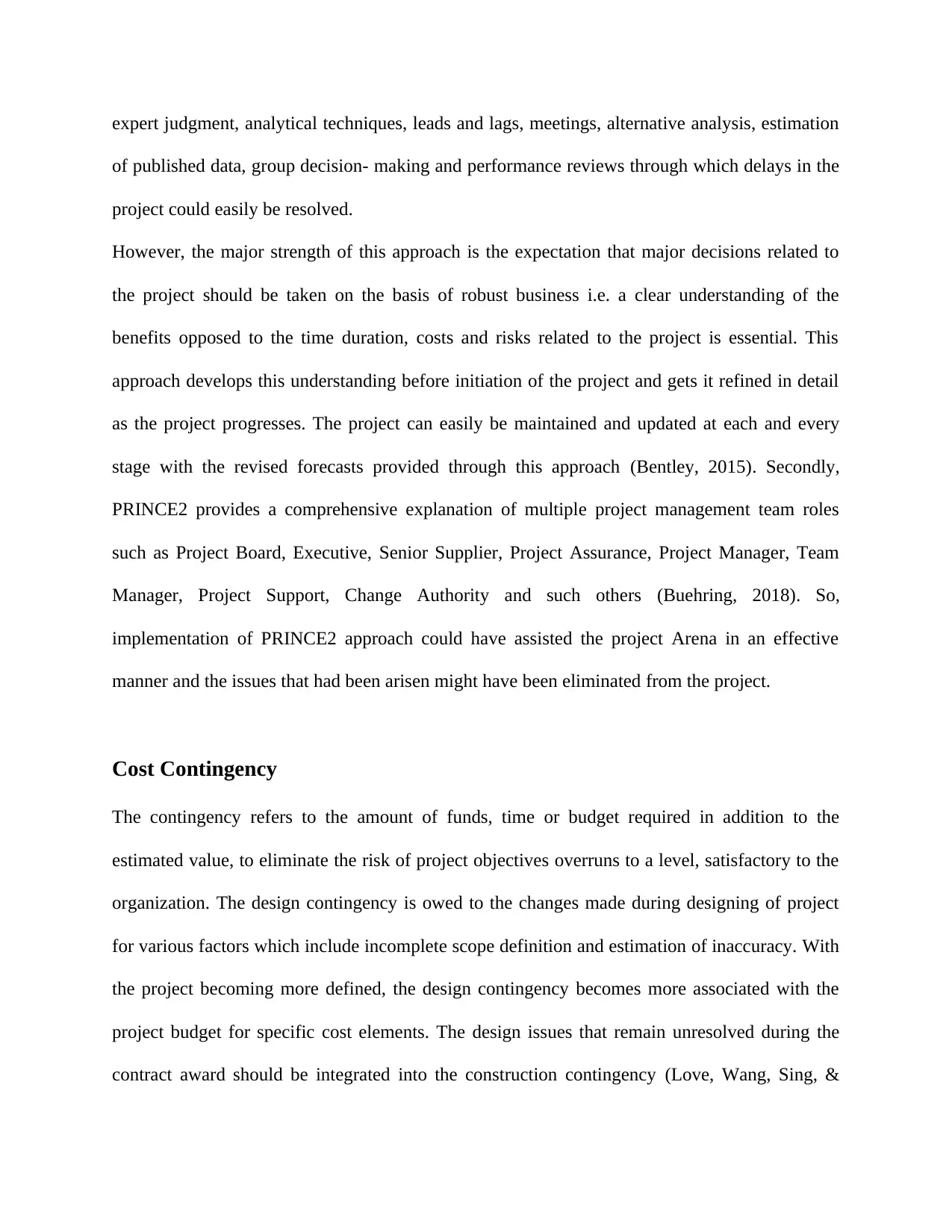
expert judgment, analytical techniques, leads and lags, meetings, alternative analysis, estimation
of published data, group decision- making and performance reviews through which delays in the
project could easily be resolved.
However, the major strength of this approach is the expectation that major decisions related to
the project should be taken on the basis of robust business i.e. a clear understanding of the
benefits opposed to the time duration, costs and risks related to the project is essential. This
approach develops this understanding before initiation of the project and gets it refined in detail
as the project progresses. The project can easily be maintained and updated at each and every
stage with the revised forecasts provided through this approach (Bentley, 2015). Secondly,
PRINCE2 provides a comprehensive explanation of multiple project management team roles
such as Project Board, Executive, Senior Supplier, Project Assurance, Project Manager, Team
Manager, Project Support, Change Authority and such others (Buehring, 2018). So,
implementation of PRINCE2 approach could have assisted the project Arena in an effective
manner and the issues that had been arisen might have been eliminated from the project.
Cost Contingency
The contingency refers to the amount of funds, time or budget required in addition to the
estimated value, to eliminate the risk of project objectives overruns to a level, satisfactory to the
organization. The design contingency is owed to the changes made during designing of project
for various factors which include incomplete scope definition and estimation of inaccuracy. With
the project becoming more defined, the design contingency becomes more associated with the
project budget for specific cost elements. The design issues that remain unresolved during the
contract award should be integrated into the construction contingency (Love, Wang, Sing, &
of published data, group decision- making and performance reviews through which delays in the
project could easily be resolved.
However, the major strength of this approach is the expectation that major decisions related to
the project should be taken on the basis of robust business i.e. a clear understanding of the
benefits opposed to the time duration, costs and risks related to the project is essential. This
approach develops this understanding before initiation of the project and gets it refined in detail
as the project progresses. The project can easily be maintained and updated at each and every
stage with the revised forecasts provided through this approach (Bentley, 2015). Secondly,
PRINCE2 provides a comprehensive explanation of multiple project management team roles
such as Project Board, Executive, Senior Supplier, Project Assurance, Project Manager, Team
Manager, Project Support, Change Authority and such others (Buehring, 2018). So,
implementation of PRINCE2 approach could have assisted the project Arena in an effective
manner and the issues that had been arisen might have been eliminated from the project.
Cost Contingency
The contingency refers to the amount of funds, time or budget required in addition to the
estimated value, to eliminate the risk of project objectives overruns to a level, satisfactory to the
organization. The design contingency is owed to the changes made during designing of project
for various factors which include incomplete scope definition and estimation of inaccuracy. With
the project becoming more defined, the design contingency becomes more associated with the
project budget for specific cost elements. The design issues that remain unresolved during the
contract award should be integrated into the construction contingency (Love, Wang, Sing, &
Paraphrase This Document
Need a fresh take? Get an instant paraphrase of this document with our AI Paraphraser
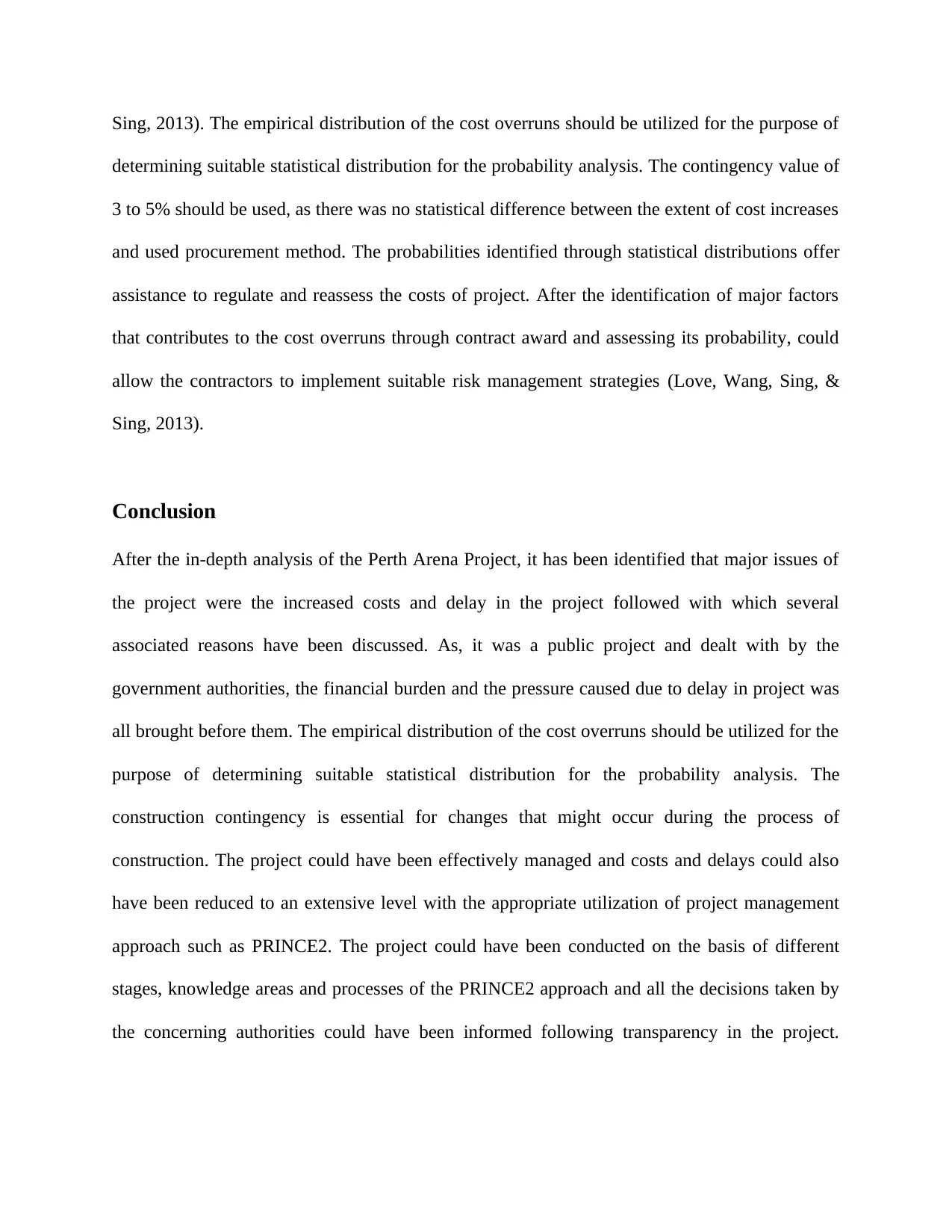
Sing, 2013). The empirical distribution of the cost overruns should be utilized for the purpose of
determining suitable statistical distribution for the probability analysis. The contingency value of
3 to 5% should be used, as there was no statistical difference between the extent of cost increases
and used procurement method. The probabilities identified through statistical distributions offer
assistance to regulate and reassess the costs of project. After the identification of major factors
that contributes to the cost overruns through contract award and assessing its probability, could
allow the contractors to implement suitable risk management strategies (Love, Wang, Sing, &
Sing, 2013).
Conclusion
After the in-depth analysis of the Perth Arena Project, it has been identified that major issues of
the project were the increased costs and delay in the project followed with which several
associated reasons have been discussed. As, it was a public project and dealt with by the
government authorities, the financial burden and the pressure caused due to delay in project was
all brought before them. The empirical distribution of the cost overruns should be utilized for the
purpose of determining suitable statistical distribution for the probability analysis. The
construction contingency is essential for changes that might occur during the process of
construction. The project could have been effectively managed and costs and delays could also
have been reduced to an extensive level with the appropriate utilization of project management
approach such as PRINCE2. The project could have been conducted on the basis of different
stages, knowledge areas and processes of the PRINCE2 approach and all the decisions taken by
the concerning authorities could have been informed following transparency in the project.
determining suitable statistical distribution for the probability analysis. The contingency value of
3 to 5% should be used, as there was no statistical difference between the extent of cost increases
and used procurement method. The probabilities identified through statistical distributions offer
assistance to regulate and reassess the costs of project. After the identification of major factors
that contributes to the cost overruns through contract award and assessing its probability, could
allow the contractors to implement suitable risk management strategies (Love, Wang, Sing, &
Sing, 2013).
Conclusion
After the in-depth analysis of the Perth Arena Project, it has been identified that major issues of
the project were the increased costs and delay in the project followed with which several
associated reasons have been discussed. As, it was a public project and dealt with by the
government authorities, the financial burden and the pressure caused due to delay in project was
all brought before them. The empirical distribution of the cost overruns should be utilized for the
purpose of determining suitable statistical distribution for the probability analysis. The
construction contingency is essential for changes that might occur during the process of
construction. The project could have been effectively managed and costs and delays could also
have been reduced to an extensive level with the appropriate utilization of project management
approach such as PRINCE2. The project could have been conducted on the basis of different
stages, knowledge areas and processes of the PRINCE2 approach and all the decisions taken by
the concerning authorities could have been informed following transparency in the project.
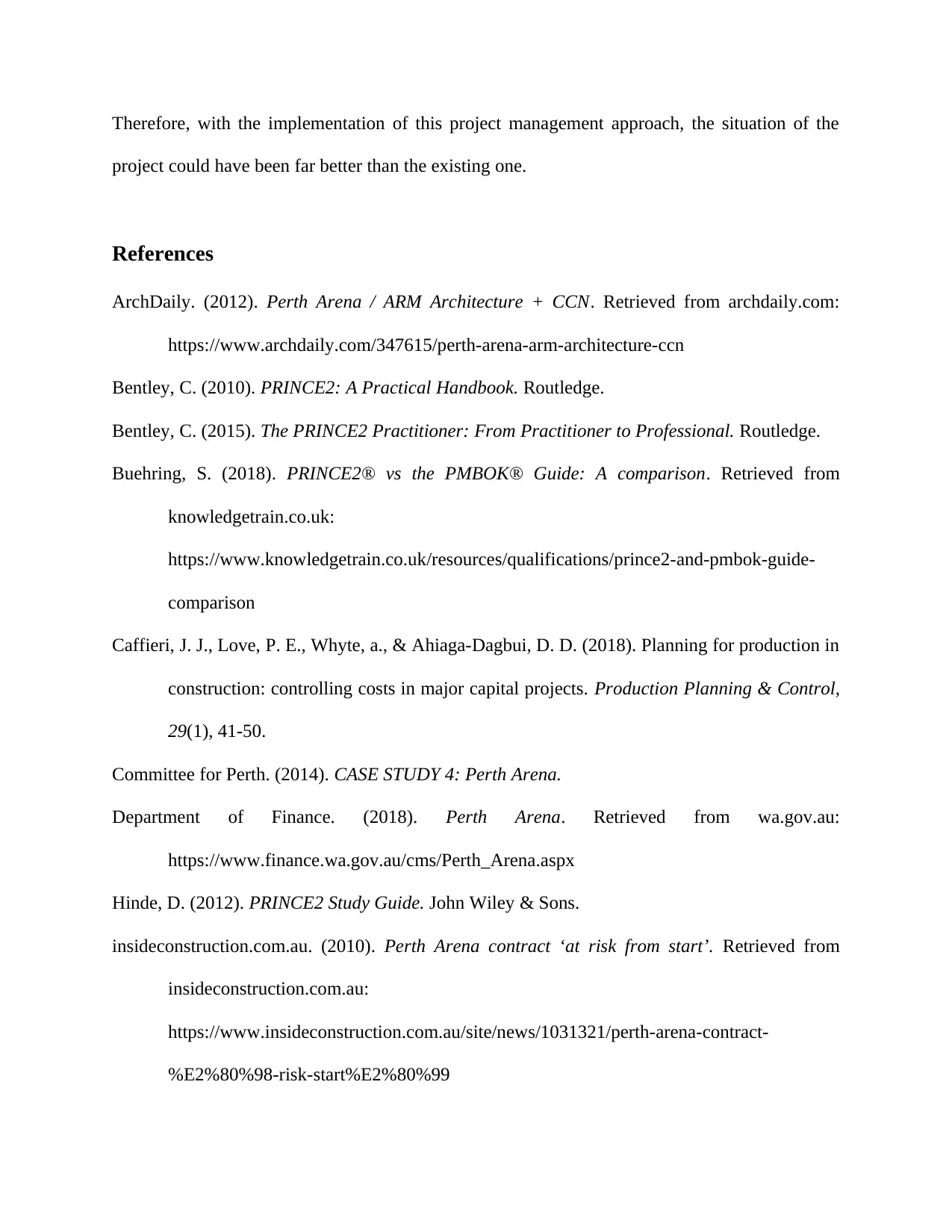
Therefore, with the implementation of this project management approach, the situation of the
project could have been far better than the existing one.
References
ArchDaily. (2012). Perth Arena / ARM Architecture + CCN. Retrieved from archdaily.com:
https://www.archdaily.com/347615/perth-arena-arm-architecture-ccn
Bentley, C. (2010). PRINCE2: A Practical Handbook. Routledge.
Bentley, C. (2015). The PRINCE2 Practitioner: From Practitioner to Professional. Routledge.
Buehring, S. (2018). PRINCE2® vs the PMBOK® Guide: A comparison. Retrieved from
knowledgetrain.co.uk:
https://www.knowledgetrain.co.uk/resources/qualifications/prince2-and-pmbok-guide-
comparison
Caffieri, J. J., Love, P. E., Whyte, a., & Ahiaga-Dagbui, D. D. (2018). Planning for production in
construction: controlling costs in major capital projects. Production Planning & Control,
29(1), 41-50.
Committee for Perth. (2014). CASE STUDY 4: Perth Arena.
Department of Finance. (2018). Perth Arena. Retrieved from wa.gov.au:
https://www.finance.wa.gov.au/cms/Perth_Arena.aspx
Hinde, D. (2012). PRINCE2 Study Guide. John Wiley & Sons.
insideconstruction.com.au. (2010). Perth Arena contract ‘at risk from start’. Retrieved from
insideconstruction.com.au:
https://www.insideconstruction.com.au/site/news/1031321/perth-arena-contract-
%E2%80%98-risk-start%E2%80%99
project could have been far better than the existing one.
References
ArchDaily. (2012). Perth Arena / ARM Architecture + CCN. Retrieved from archdaily.com:
https://www.archdaily.com/347615/perth-arena-arm-architecture-ccn
Bentley, C. (2010). PRINCE2: A Practical Handbook. Routledge.
Bentley, C. (2015). The PRINCE2 Practitioner: From Practitioner to Professional. Routledge.
Buehring, S. (2018). PRINCE2® vs the PMBOK® Guide: A comparison. Retrieved from
knowledgetrain.co.uk:
https://www.knowledgetrain.co.uk/resources/qualifications/prince2-and-pmbok-guide-
comparison
Caffieri, J. J., Love, P. E., Whyte, a., & Ahiaga-Dagbui, D. D. (2018). Planning for production in
construction: controlling costs in major capital projects. Production Planning & Control,
29(1), 41-50.
Committee for Perth. (2014). CASE STUDY 4: Perth Arena.
Department of Finance. (2018). Perth Arena. Retrieved from wa.gov.au:
https://www.finance.wa.gov.au/cms/Perth_Arena.aspx
Hinde, D. (2012). PRINCE2 Study Guide. John Wiley & Sons.
insideconstruction.com.au. (2010). Perth Arena contract ‘at risk from start’. Retrieved from
insideconstruction.com.au:
https://www.insideconstruction.com.au/site/news/1031321/perth-arena-contract-
%E2%80%98-risk-start%E2%80%99
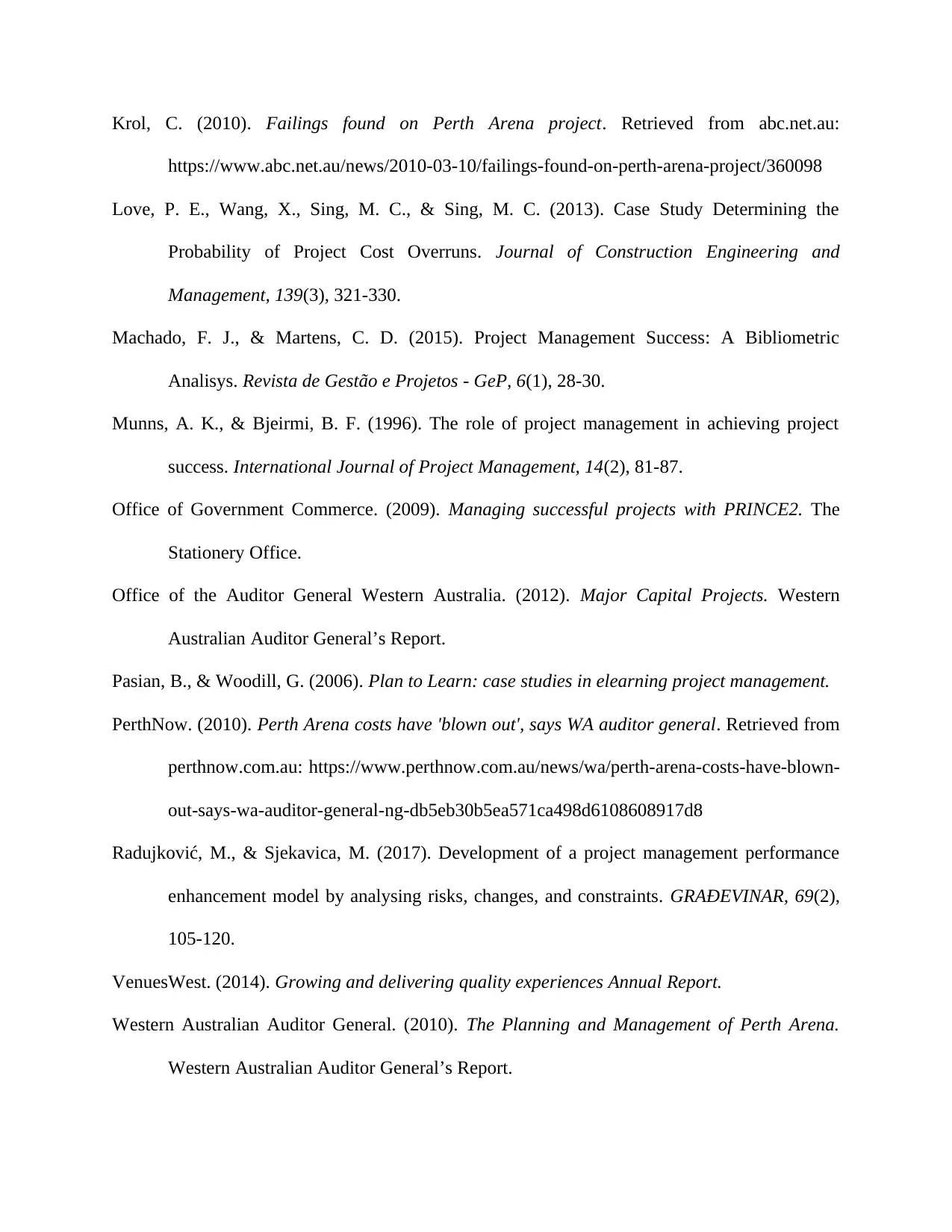
Krol, C. (2010). Failings found on Perth Arena project. Retrieved from abc.net.au:
https://www.abc.net.au/news/2010-03-10/failings-found-on-perth-arena-project/360098
Love, P. E., Wang, X., Sing, M. C., & Sing, M. C. (2013). Case Study Determining the
Probability of Project Cost Overruns. Journal of Construction Engineering and
Management, 139(3), 321-330.
Machado, F. J., & Martens, C. D. (2015). Project Management Success: A Bibliometric
Analisys. Revista de Gestão e Projetos - GeP, 6(1), 28-30.
Munns, A. K., & Bjeirmi, B. F. (1996). The role of project management in achieving project
success. International Journal of Project Management, 14(2), 81-87.
Office of Government Commerce. (2009). Managing successful projects with PRINCE2. The
Stationery Office.
Office of the Auditor General Western Australia. (2012). Major Capital Projects. Western
Australian Auditor General’s Report.
Pasian, B., & Woodill, G. (2006). Plan to Learn: case studies in elearning project management.
PerthNow. (2010). Perth Arena costs have 'blown out', says WA auditor general. Retrieved from
perthnow.com.au: https://www.perthnow.com.au/news/wa/perth-arena-costs-have-blown-
out-says-wa-auditor-general-ng-db5eb30b5ea571ca498d6108608917d8
Radujković, M., & Sjekavica, M. (2017). Development of a project management performance
enhancement model by analysing risks, changes, and constraints. GRAĐEVINAR, 69(2),
105-120.
VenuesWest. (2014). Growing and delivering quality experiences Annual Report.
Western Australian Auditor General. (2010). The Planning and Management of Perth Arena.
Western Australian Auditor General’s Report.
https://www.abc.net.au/news/2010-03-10/failings-found-on-perth-arena-project/360098
Love, P. E., Wang, X., Sing, M. C., & Sing, M. C. (2013). Case Study Determining the
Probability of Project Cost Overruns. Journal of Construction Engineering and
Management, 139(3), 321-330.
Machado, F. J., & Martens, C. D. (2015). Project Management Success: A Bibliometric
Analisys. Revista de Gestão e Projetos - GeP, 6(1), 28-30.
Munns, A. K., & Bjeirmi, B. F. (1996). The role of project management in achieving project
success. International Journal of Project Management, 14(2), 81-87.
Office of Government Commerce. (2009). Managing successful projects with PRINCE2. The
Stationery Office.
Office of the Auditor General Western Australia. (2012). Major Capital Projects. Western
Australian Auditor General’s Report.
Pasian, B., & Woodill, G. (2006). Plan to Learn: case studies in elearning project management.
PerthNow. (2010). Perth Arena costs have 'blown out', says WA auditor general. Retrieved from
perthnow.com.au: https://www.perthnow.com.au/news/wa/perth-arena-costs-have-blown-
out-says-wa-auditor-general-ng-db5eb30b5ea571ca498d6108608917d8
Radujković, M., & Sjekavica, M. (2017). Development of a project management performance
enhancement model by analysing risks, changes, and constraints. GRAĐEVINAR, 69(2),
105-120.
VenuesWest. (2014). Growing and delivering quality experiences Annual Report.
Western Australian Auditor General. (2010). The Planning and Management of Perth Arena.
Western Australian Auditor General’s Report.
Secure Best Marks with AI Grader
Need help grading? Try our AI Grader for instant feedback on your assignments.

WSP. (2018). Perth Arena. Retrieved from wsp.com:
https://www.wsp.com/en-GL/projects/perth-arena
https://www.wsp.com/en-GL/projects/perth-arena
1 out of 17
Related Documents
Your All-in-One AI-Powered Toolkit for Academic Success.
+13062052269
info@desklib.com
Available 24*7 on WhatsApp / Email
![[object Object]](/_next/static/media/star-bottom.7253800d.svg)
Unlock your academic potential
© 2024 | Zucol Services PVT LTD | All rights reserved.




